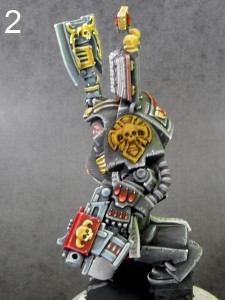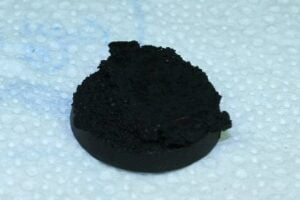In this tutorial explaining how to paint ruins bases from Micro Art Studio, I’m going to show you two of many possible colour schemes which you can use while painting ruins – first one will be with standard grey colours, like if you’re in some sort of castle (and later on I’ll call grey bases “castle bases”), and the second one will be “desert ruins” – some kind of old temple/church, once great, now forgotten. So, without any more introductions, here we go:
How to paint ruin bases: The ground
Step 1:
First thing you need to do, is basecoat your bases. I did it with Vallejo 950 Black, just because I ran out of both Citadel paint and spray:
Step 2:
So, now what to do next… Which part, which element now? Well, first thing you want to ask yourself, is: How much time do I want to spend on 1 base? Is it 1 minute? Maybe 5? Can I spend 20 minutes on 1 base? And, most importantly, will it be worth that time?
Well, let’s assume that we want to do it fast, without going back to destroyed elements, because we must do 200 of them. In that case I suggest you to make the deepest parts of the base – in this particular case, the earth. I used Citadel brown colour Mournfang Brown, old Bestial Brown, which I applied normally on specific parts. Remember – you don’t have to be precise at this part, so don’t waste your time trying not to paint stones:
Step 3:
After that step was done, I decided that I’ll create some shadows on the earth, to make deeper parts darker. I could just drybrush those parts where the earth should be brown instead of painting it, leaving black shadows everywhere – but I want dark brown shadows, not black.
That’s why I decided to use Citadel Agrax Earthshade shade, which I applied on brown parts. The same effect I could accuire using darker brown as a prime earth colour, and then drybrushing those parts with Mournfang Brown – pick your favourite method:
Step 4:
Next thing to do is light up the earth a bit – I mixed 1:1 Mournfang Bown and Citadel Ushabti Bone, and then applied it on brown parts with light drybrush:
Step 5:
To finish up the earth, I lightly drybrushed every brown part with pure Ushabti Bone – remember, make sure your brush is really dry, otherwise you’ll ruin the whole effect! It’s better to mix or even waste more paint that do everything from the beginning:
Step 6:
As the earth is done, we can go on. Next and last, in this particular case, thing we have to do, is paint stones. At this point I separated bases – 3 for grey bases, 2 for desert ones. From now on, we’ll split the tutorial into two parts – one about each kind of bases.
How to paint grey ruins bases
Step 7a:
While painting the earth you didn’t have to care about precision – now you have to. Especially near the painted brown earth. So I applied very gently 1 layer of Citadel Eshin Grey paint. I think that it’s the second darkest grey colour they offer, comparable to Mechanicus Standard Grey, which you can also use here. That’s how it looks (notice that we don’t care about the rims of base at all right now):
Step 8a:
After painting it with your favourite grey colour, I mixed 3 parts of Eshin Grey with 2 parts of Ceramite White, and then quite heavily drybrushed the whole base (but be careful, don’t destroy your beautiful earth!):
Step 9a:
Next step is to light it more – you can mix 2 parts of Eshin Grey with 3 parts of Ceramite White, or simply use colour named Administratium Grey. It will look pretty much the same.
Then again, drybrush the whole base – but now lightly. Pick your way with that – I decided that I’ll make sides of the base lighter. You can choose differently:
Step 10a:
The only thing to do now is to make one, final highlight – take your white paint and apply it very gently using drybrush on parts which were before treated with Administratium Grey. At this point, after you finish with white, you’ll also have to paint rim of the base with black colour – Abaddon Black from Citadel or any other black paint (like my 950 Vallejo black). And after doing so, your bases are done.
Here’s the final effect:
Let’s move on to the desert bases.
How to paint desert ruins bases
Step 7b:
Let’s move on from the common part about painting ground, as parts from basecoating up to fully painted earth are the same in both cases. Here again, while painting the earth you didn’t have to care about precision – now you have to. I used Citadel Tallarn Sand as a prime colour for those stones:
Step 8b:
Then I came up with an idea – why do I have to make it look like just plain stones with highlights, can’t I add anything catchy, something that will make my base special?
Well, if it’s old ruined temple why not some frescoes? You can make them as you want, with many colours or very few, big or small, untouched or very destroyed, simple patterns, complicated or just some letters. I made a simple pattern on the side of base – line of purple(Citadel Xereus Purple) and turquoise (Citadel Sotek Green) triangles accompanied with blacklining:
Step 9b:
As for something that is destroyed (in my case), frescoes also have to in bad shape. That’s why I “scratched” some frescoes paint from the edges of the base, and made some cracks inside the painting. After that, I used Citadel Seraphim Sephia shade to make shades all over the base (I skipped the earlier painted earth of course):
Step 10b:
Ok, frescoes are destroyed, bases have shading. Let’s move on a little bit, and start lighting things up. Before you’ll grab a brush, think for a while – how I want my base to be highlighted? Centre of it, just edges or maybe some other pattern?
I’ve decided to highlight edges and a little bit of centre of my base.
I used mix of 2:3 Ushabti Bone and Tallarn Sand, and then drybrushed the whole base lightly. Remember, you should also drybrush frescoes, but do it gently, otherwise you’ll ruin the whole effect by covering them fully:
Step 11b:
Then I reversed proportions, and made a mix of 3:2 Ushabti Bone and Tallarn Sand. After that, I heavily drubrushed the area of stones and very lightly frescoes:
Step 12b:
And at the end, I drybrushed whole base lightly with Citadel Ushabti Bone and painted the rims of the bases with black. That’s the end of making desert bases, here’s final effect:
Finished ruin bases
And so, here it is, the final effect of my work on 1 picture. A perfect bases for your Dwarf, Empire, Tomb King or any other army you want, which you can easily make by yourself in a matter of minutes!
List of used paints
- Abbadon Black, Vallejo 950 – Basecoat, frescoes blacklining
- Mournfang Brown – color of the earth
- Agrax Earthshade – Shade used on earth
- Ushabti Bone – Highlights on desert bases and earth
- Eshin Grey – Prime colour for castle bases
- Administratium Grey – highlights on castle bases
- Ceramite White – Highlights on desert and castle bases
- Tallarn Sand – Prime colour of desert bases
- Seraphim Sephia – Shade used on desert bases
- Sotek Green – frescoes triangles
- Xereus Purple – frescoes triangles
– Lemartes
























































